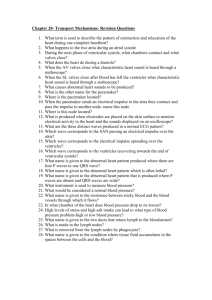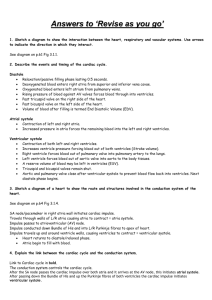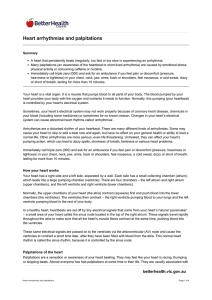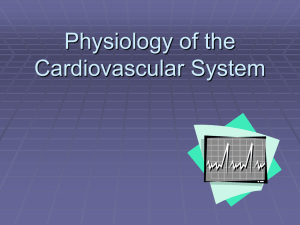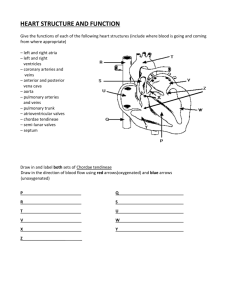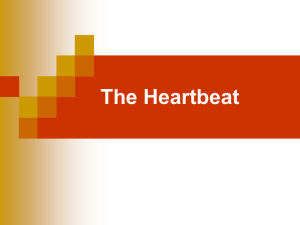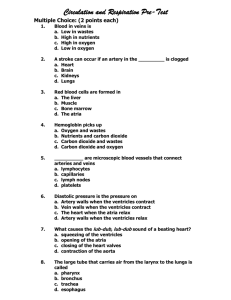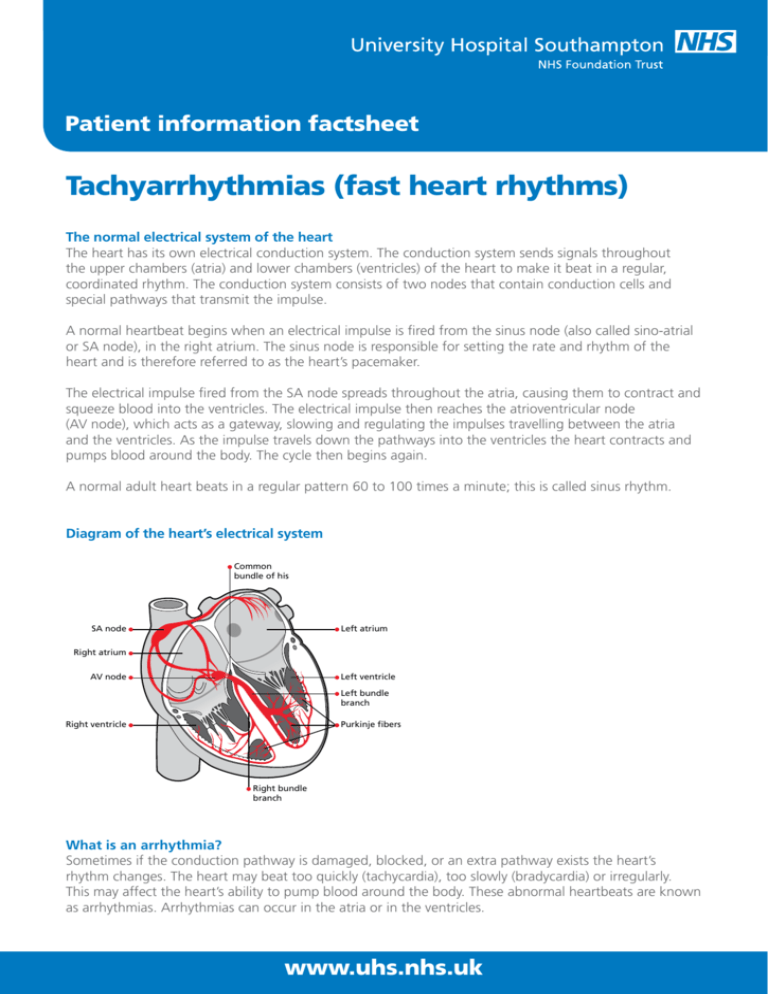
Patient information factsheet
Patient information factsheet
Tachyarrhythmias (fast heart rhythms)
The normal electrical system of the heart
The heart has its own electrical conduction system. The conduction system sends signals throughout
the upper chambers (atria) and lower chambers (ventricles) of the heart to make it beat in a regular,
coordinated rhythm. The conduction system consists of two nodes that contain conduction cells and
special pathways that transmit the impulse.
A normal heartbeat begins when an electrical impulse is fired from the sinus node (also called sino-atrial
or SA node), in the right atrium. The sinus node is responsible for setting the rate and rhythm of the
heart and is therefore referred to as the heart’s pacemaker.
The electrical impulse fired from the SA node spreads throughout the atria, causing them to contract and
squeeze blood into the ventricles. The electrical impulse then reaches the atrioventricular node
(AV node), which acts as a gateway, slowing and regulating the impulses travelling between the atria
and the ventricles. As the impulse travels down the pathways into the ventricles the heart contracts and
pumps blood around the body. The cycle then begins again.
A normal adult heart beats in a regular pattern 60 to 100 times a minute; this is called sinus rhythm.
Diagram of the heart’s electrical system
Common
bundle of his
Left atrium
SA node
Right atrium
AV node
Left ventricle
Left bundle
branch
Right ventricle
Purkinje fibers
Right bundle
branch
What is an arrhythmia?
Sometimes if the conduction pathway is damaged, blocked, or an extra pathway exists the heart’s
rhythm changes. The heart may beat too quickly (tachycardia), too slowly (bradycardia) or irregularly.
This may affect the heart’s ability to pump blood around the body. These abnormal heartbeats are known
as arrhythmias. Arrhythmias can occur in the atria or in the ventricles.
www.uhs.nhs.uk
Patient information factsheet
Causes of an arrhythmia
Any interruption in the heart’s electrical system can cause an arrhythmia. For example, an irregular
heartbeat may begin with an abnormal impulse in a part of the heart other than the normal pacemaker
(the sinus node). Or the sinus node may develop an abnormal rate or rhythm.
Common causes of arrhythmias include stress, caffeine, tobacco, alcohol, diet pills and cough and cold
medicines. If your heart tissue is damaged as a result of acquired heart disease, such as myocardial
infarction (heart attack) or congenital heart disease you may be at risk of developing arrhythmias.
Occasionally it may be a familial or inherited disorder. For some patients, however, doctors cannot
identify a cause of their arrhythmias.
Diagnosing your arrhythmia
If your doctor suspects that you may have an arrhythmia, one or more of the following tests may be
performed to determine the cause of your symptoms.
Electrocardiogram (ECG)
An electrocardiogram is a recording of the electrical activity of your heart. Electrode stickers are placed
on your chest and connected by wires to a recording machine. Your heart’s electrical signals produce
a pattern on graph paper in the ECG. By analysing the pattern of these waves, your doctor can often
determine what type of arrhythmia you have. ECG testing may be done while you are resting, or while
you are exercising on a treadmill.
Holter monitor
A Holter monitor shows changes in your heart rhythm over the course of a 24-hour period that may not
be detected during a resting or exercise ECG. You will be asked to go about your daily activities as usual
(except for showering or bathing) while you wear a small, portable recorder that connects to electrode
stickers on your chest. You will then come back to the hospital the next day so that the information can
be retrieved and analysed.
Cardiac event monitor
If your doctor feels you need to be monitored for several days or weeks, you may need to have a cardiac
event monitor. This type of recording device is used if your arrhythmias are infrequent. This device is
about the size of a large pager, and can be clipped to your belt or waistband or carried in your bag or
pocket. When you feel symptoms, you simply hold the recorder against your chest and press a button.
The device then records up to 70 seconds of ECG readings.
Types of arrhythmia
Arrhythmias that occur in the atria are either atrial or supraventricular (above the ventricles) in origin,
whereas ventricular arrhythmias start in the ventricles. While some arrhythmias are merely a nuisance,
others can be life threatening. In general, ventricular arrhythmias caused by heart disease are the most
serious kind, and require prompt medical attention.
Supraventricular tachycardia (SVT)
This type of arrhythmia commonly occurs in young, healthy people. Doctors often refer to SVT as
re-entry tachycardia. This is because the electrical impulse does not fade out as with the normal
heartbeat, but continues to move in a rapid circle within the conduction system. This is due to an extra
electrical pathway that can form a short circuit within the heart’s conduction system. SVT is usually a
www.uhs.nhs.uk
Patient information factsheet
rapid, regular rhythm. The two most common types of SVT are AV-nodal re-entry tachycardia and
AV re-entry tachycardia (AVRT), most commonly known as Wolff-Parkinson-White syndrome (WPW).
AV nodal re-entry tachycardia (AVNRT)
This type of arrhythmia occurs when a problem arises in the way the electrical impulses pass through the
AV node. Normally, the AV node acts as a gateway, slowing and regulating the impulses as they travel
between the atria and the ventricles. In AVNRT there are two pathways, known as dual conduction
pathways that can pass impulses to and from the AV node. This type of arrhythmia usually starts
following an early beat (ectopic). An electrical short circuit then occurs where the electrical impulse
rotates around the circuit and with each cycle pass to the ventricles, resulting in a very fast heartbeat.
AV re-entry tachycardia (AVRT) or Wolff-Parkinson-White syndrome (WPW)
In AVRT an extra electrical pathway exists that bypasses the normal conduction system. The pathway
directly connects the atria to the ventricles. This extra pathway is known as an accessory pathway.
The electrical impulses travel along the accessory pathway, bypassing the AV node. The tissue in the
pathway does not slow the impulse down, as in the AV node. Therefore the electrical impulses reach the
ventricles before the normal electrical impulse (this is known as pre-excitation). An ECG recording of a
patient with WPW syndrome will often show a delta wave, which shows the existence of an extra electrical
pathway. Very fast heart rates may occur as the electrical impulse bounces between the atria and ventricles.
Atrial fibrillation
Atrial fibrillation (AF) is one of the most common types of arrhythmia. AF occurs in the atria.
The electrical impulse normally originates at the SA node. However in atrial fibrillation, many electrical
impulses are fired rapidly and at random throughout the atria down to the ventricles. The resulting
heartbeat is irregular and usually fast. When the atria are beating rapidly and irregularly (fibrillating) they
are unable to completely empty all of the blood they receive into the ventricles. This can cause blood
clots to form. Therefore, to prevent you being at an increased risk of stroke you will be treated with an
anticoagulant (blood thinner).
Atrial flutter
Atrial flutter also occurs in the atria. The electrical impulses fire rapidly but the resulting rhythm is regular
and organised. The rhythm is due to a re-entry circuit within the atria, where the electrical impulse travels
in circles leaving and arriving back at the same point.
Ventricular tachycardia (VT)
VT occurs when the electrical impulses arise in the ventricles. The ventricles start beating at an
abnormally fast, regular rate. When the ventricles are beating rapidly the heart does not work as
efficiently, causing symptoms of weakness, dizziness, chest pain, shortness of breath or even collapse.
There are several different types of VT and the seriousness of the condition can vary. VT can be a
potentially life threatening heart rhythm as it can progress to ventricular fibrillation and cause the heart
to stop beating (cardiac arrest).
There are a number of reasons that people may develop VT. For example, in people who have had a
previous myocardial infarction (heart attack) the area of the heart muscle damaged by the heart attack
forms scar tissue. This can make the heart susceptible to abnormal heart rhythms. Other people who may
experience VT are patients with cardiomyopathy, previous corrective congenital heart surgery or inherited
arrhythmias. There is also a small group of people who have VT with a structurally normal heart.
www.uhs.nhs.uk
Patient information factsheet
Ventricular fibrillation
Ventricular fibrillation occurs in the ventricles. In ventricular fibrillation, the electrical impulses are fired
from multiple sites in the ventricles in a very fast and irregular way, causing the heart to quiver rather
than to beat and pump blood. Ventricular fibrillation is a life threatening emergency requiring prompt
medical treatment to prevent a fatality.
Treatments
The results of the tests you have had will determine the type and seriousness of your arrhythmia.
Your doctor will then discuss your treatment options with you. Many patients with arrhythmias require
no further treatment. The most important aspect of any initial evaluation is to determine the
significance of the arrhythmia and the need for any type of intervention.
Medicines
There are a number of drugs that can be used to treat your arrhythmia. Anti-arrhythmic drugs are
medicines that change the electrical signals in your heart and help prevent irregular or rapid heart rhythms.
Permanent pacemaker
If you have atrial fibrillation, which has proved difficult to treat, your doctor may recommend you have a
pacemaker fitted in conjunction with a procedure called an atrioventricular (AV) node ablation. An AV node
ablation and permanent pacemaker insertion will regulate the heart rate and provide symptomatic relief.
A pacemaker is a small device used to treat slow heart rhythms. It is implanted beneath the skin below
the collarbone and connected to a pacing wire placed inside the heart. The pacemaker delivers a small
electrical impulse to stimulate the heart to beat when it is going too slowly.
Radiofrequency (heat) energy / cryo (cold) energy catheter ablation
If you have an extra electrical pathway or group of cells (foci) your doctor may advise you to have a
catheter ablation. A catheter ablation creates scar tissue that blocks the area of extra electrical activity
causing the arrhythmias. This provides relief for those of you who may not have responded well to
medications, or who would rather not or cannot take medications. This technique has a high percentage
of success in treating many types of arrhythmias.
Internal cardioversion
Internal cardioversion is a low energy electrical shock delivered inside the heart. Two catheters are
inserted into a vein in your groin and a small electrode pad applied to your chest.
During the internal cardioversion, you will be given a short acting sedative to make you sleepy. Internal
cardioversion is performed when medications and external cardioversion have been unsuccessful in
returning the heart’s rhythm back to a normal sinus rhythm.
Implantable cardioverter defibrillator (ICD)
This is a device for people who are at risk of life threatening heart rhythms. It is slightly larger than a
pacemaker and usually implanted beneath the skin below the collarbone. The ICD is connected via leads
which are positioned inside the heart. It has the ability to determine and stop fast ventricular arrhythmias
by using extra paced beats known as anti tachycardia pacing (ATP) or by delivering an electric shock to
the heart. It is also capable of pacing the heart to stop it from going too slowly.
www.uhs.nhs.uk
Patient information factsheet
Cancellations
Unfortunately we do sometimes have to cancel procedures. If this happens to you, we will always try to
explain the reason. We fully appreciate that this is a stressful time for you and your family and we will do
our best to provide you with a new date that is convenient for you as soon as possible.
Further information and contacts
We cannot guarantee that a particular person will perform the procedure. The person will, however,
have appropriate experience.
If you have any questions regarding your forthcoming procedure please call 023 8120 8436 to speak to
a cardiac rhythm management clinical nurse specialist. If you have a query relating your admission date
please contact the cardiac rhythm management coordinator on 023 8120 8772.
You can also email crmnurses@uhs.nhs.uk
The following websites also provide useful information:
www.bhf.org.uk
www.heartrhythmcharity.org.uk
If you need a translation of this document, an interpreter
or a version in large print, Braille or on audio tape, please
telephone 023 8120 4688 for help.
© 2015 University Hospital Southampton NHS Foundation Trust. All rights reserved. Not to be reproduced in whole or in part without the permission of the copyright holder.
Version 4. Published April 2015. Due for review April 2018. 2014-727(4)
www.uhs.nhs.uk

